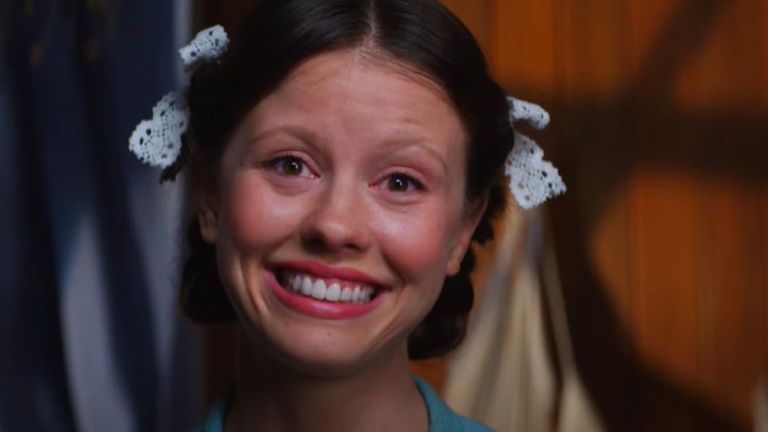Pearl Makes Ti West’s X Even Better
The Ti West movie X makes pornography look like a killer industry, but his prequel Pearl shows that any movie can drive you nuts.

“No ma’am, we don’t need Hollywood,” would-be movie producer Wayne tells his crew at the start of the horror film X. “These types of pictures turn regular folks into stars.”
The type of pictures in question are pornographic films, for which Wayne (Martin Henderson) has assembled a small cast and crew and brought them to a secluded Texas farmhouse. Set in 1979, the slasher X not only pays homage to the decade’s grisly and low-budget horror movies but it also captures a moment in which loosening obscenity laws and increased home viewing options make pornography a profitable business.
A few months after X hit theaters, director Ti West released the prequel film Pearl, which he co-wrote with star Mia Goth. Pearl takes place in 1918, long before changing mores made pornography prevalent. In fact, pornography appears only briefly in Pearl, when projectionist (future Superman David Cornswet) tries to impress the farm girl by playing an illicit reel. However, Pearl too involves a woman who wants to become a star, someone who knows she isn’t “regular folks” despite her mundane rural surroundings.
Viewers of X might be tempted to see a moralistic message in the movie, one that associates pornography and rampant sexuality with death and murder, a tried and true slasher movie trope. But Pearl goes even further to identify every form of cinema, with its spectacular recreation of everyday life, as just as harmful when in the hands of psychopaths who reject their reality.
Beginning With the Movies In Mind
West connects X to Pearl with the respective films’ opening shots. Both movies begin with images of the farmhouse where most of the films take place, shot through the doors of a barn. While the image tells viewers that the two movies share the same setting, it also signals their different approaches to the central theme.
X begins with a static shot of the farmhouse from inside the barn. The drone of cicadas greets the viewer during the production logos, before we even see the movie proper. Once the film begins, the camera sits inside the barn as a police car drives up to the farmhouse.
During these still moments, the shot appears to be in boxy Academy ratio, recalling a film slide or the crime scene photographs of The Texas Chainsaw Massacre, X’s clearest antecedent. But when the police car arrives, the camera pushes in toward the farmhouse, revealing the borders of the frame to not be the edges of a slide, but the doors of a barn in which the camera began.
Pearl also opens by looking at the farmhouse through a barn. Instead of standing still and observing, the camera moves with intention, pushing forward toward the house to the strains of Tyler Bates and Chelsea Wolfe’s swooping, romantic score. Still in its pristine glory, the farmhouse glows in the morning sun, the blues and greens enhanced by a technicolor glow. Opening credits unfurl across the screen in the manner of classic movies.
These two shots blur the line between reality and the pictures, showing us how Pearl in her youth and old age (played in both cases by Goth) understands the world through the perspective of movies. However, the radical difference between the two genres — the porno that Wayne wants to shoot with stars Maxine (Goth), Jackson Hole (Scott Mescudi), and Bobby-Lynne Parker (Brittany Snow) — and the song and dance romances that entrance young Pearl could not be more different. But together, they underscore the mindset that drives Pearl to kill, first in 1918 and later in 1979.
What is Wrong With Pearl?
X can be a disturbing watch, and not just because of the violence on display. In the first third of the film, the elderly Pearl skulks from the edges, spying on the filmmakers. First-time viewers might assume that Pearl takes exception with the movie, a claim supported by her husband Howard’s (Stephen Ure) warnings and by the televangelist whose sermons blare throughout Pearl’s house.
However, West reveals Pearl’s true motivations with the movie’s first kill. When the group’s director RJ (Owen Campbell) attempts to leave his friends in the middle of the night, he’s stopped by Pearl in the middle of the road. When RJ gets out of his truck to check on her, Pearl makes sexual advances toward him. “Why won’t you look at me?” she asks when he backs away. “I want you to look at me like you look at her.”
When RJ gets even more disgusted, Pearl slices at his throat as the strains of “Don’t Fear the Reaper” by Blue Oyster Cult rises on the soundtrack. The lead-up to the kill led some viewers to read X as agist and sexist, treating the sexuality of an elderly woman as something inherently monstrous and disgusting.
But the scene doesn’t end with the kill. Instead, it turns romantic when blood spurts from RJ’s neck onto the truck’s headlight. A warm red light engulfs Pearl as she mounts RJ’s body and begins thrusting. The aggressive rock of Blue Oyster Cult fades from the soundtrack, replaced by the soft swooning of “Oui Oui Marie,” sung by Chelsea Wolfe.
The shift doesn’t erase the horror of RJ’s death, nor of the kills that follow. But it does disrupt our understanding of Pearl. She doesn’t just kill because she’s a horny old lady. There’s something tragic and moving about her, something that the prequel explores.
Movies Make the Best of What Pearl Has
“How ‘bout a movie nobody has ever seen?” the projectionist asks when he has the title character alone in his booth, late at night in the first act of Pearl. The black and white images of people undressing doesn’t shock Pearl, nor does it arouse her, as the projectionist had hoped. Instead, reaction shots of Pearl staring wide-eyed through the projector slot capture the wonder invoked by the nature of cinema.
“It’s reality,” the projectionist intones. “And it’s no secret that we all share a fascination in seeing people as they are.”
“I don’t like reality,” Pearl responds, and with good reason. She lives on a farm with an invalid father (Matthew Sunderland) and a stoic German mother (Tandi Wright) with Puritan instincts, who resents her flights of fancy. “One day you’ll understand getting what you want isn’t what’s important,” her mother grumbles. “Making the most of what you have is. Life rarely turns out how you expect. You need to be prepared for that if you ever want to be happy.”
The scene ends with Pearl glaring at her mother and sighing. But the ending of the film proves that she’s learned her lesson. After killing her parents and the projectionist, Pearl chases down her rival Mitsy (Emma Jenkins-Purro), the sweet blond who won a part in a traveling show, and attacks her with an axe.
“I’ll do whatever you want,” Mitsy pleads.
“It’s not what I want anymore, Mitsy,” responds Pearl. “It’s about making the most of what I have.”
That statement might sound like Pearl has resigned herself to the austerity advised by her late relatives. But the actions that follow suggest otherwise. Pearl drags her parents’ corpses to the dinner table, a process that West and cinematographer Eliot Rockett present in split screen, often with both sides of the screen mirroring one another. Undeterred, maybe even unnoticing, the corpses or the rotting ham at the center of the table, Pearl sits and prays a blessing for the meal, completing the ideal American gothic tableau.
In that moment, Pearl demonstrates how she makes the best of what she has. She takes what she has — putrefied pig flesh, dead bodies, and a stultifying farmhouse — and transforms it into something beautiful, something unreal. She transforms it into something cinematic, which is the only “better” that Pearl accepts.
In doing so, Pearl also demonstrates what she’s learned from the projectionist: that real life looks good if it looks like a movie.
Pearl’s Always Ready for Her Close-Up
In Pearl’s fantastic final shot, Pearl looks at her husband Howard (Alistair Sewell) as he returns from the front to find his wife sharing a meal with corpses. The camera holds on Pearl’s face as Goth gives a beaming, unnerving smile directly at the camera, one that she maintains throughout the entire closing credits.
More than a simple feat of Goth’s unnerving screen presence, the final shot reveals Pearl’s mindset at the end of the film, a mindset she’ll carry into old age, as seen in X. Instead of forcing us to look at Howard’s reasonable horror or the mess of rotting bodies, the camera forces us to watch Pearl’s unreal smile made all the more uncanny by the arrival of credits. The shot forces us to see Pearl as she sees herself, a movie star at the end of a beautiful cinematic production.
Pearl still sees herself that way when a bunch of would-be filmmakers happen upon her farmhouse in X. They’ve come to change from regular folks into stars, but Pearl is already a star, at least in her own mind. And when she kills her rivals throughout X, she does so not out of a sexuality that we’re supposed to fear, but out of a cinema-skewed view of reality. Together, X and Pearl suggest that any type of movie can make a monster, as long as they see the rest of the world as steps on their path to stardom.
